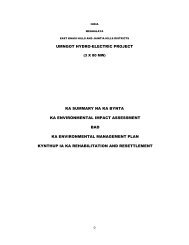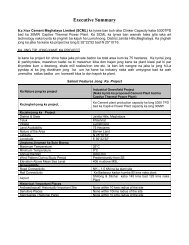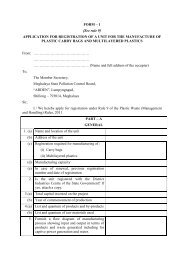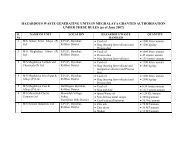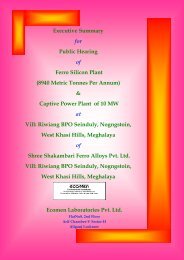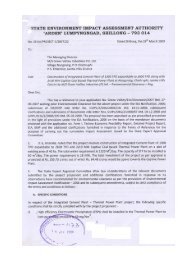chapter - 1 introduction - Meghalaya State Pollution Control Board
chapter - 1 introduction - Meghalaya State Pollution Control Board
chapter - 1 introduction - Meghalaya State Pollution Control Board
Create successful ePaper yourself
Turn your PDF publications into a flip-book with our unique Google optimized e-Paper software.
Hills Cement Co. Limited.<br />
Adjustable Speed Drive for Kiln Fan- Adjustable or Variable Speed<br />
Drives (ASDs) for the kiln fan result in reduced power use and reduced<br />
maintenance costs.<br />
The replacement of the damper by an ASD was driven by control and<br />
maintenance problems at the plant. The energy savings may not be typical<br />
for all plants, as the system arrangement of the fans is different from<br />
typical kiln arrangements.<br />
Use of Waste-Derived Fuels- Waste fuels can be substituted for<br />
traditional commercial fuels in the kiln. The trend towards increased waste<br />
use will likely to increase after successful tests with different wastes. New<br />
waste streams include carpet and plastic wastes, filter cake, paint residue<br />
and (dewatered) sewage sludge. Cement kilns also use hazardous<br />
wastes.<br />
Since the early 1990’s cement kilns burn annually almost 1 million tons of<br />
hazardous waste. The revenues from waste intake have helped to reduce<br />
the production costs of all waste-burning cement kilns, and especially of<br />
wet process kilns. Waste-derived fuels may replace the use of commercial<br />
fuels, and may result in net energy savings and reduced CO 2 emissions.<br />
The carbon dioxide emission reduction depends on the carbon content of<br />
the waste-derived fuel, as well as the alternative use of the waste and<br />
efficiency of use (e.g. incineration with or without heat recovery). The high<br />
temperatures and long residence times in the kiln destroy virtually all<br />
organic compounds, while efficient dust filters may reduce any potential<br />
emissions to safe levels.<br />
Conversion to Reciprocating Grate Cooler- Four main types of coolers<br />
is used in the cooling of clinker: shaft, rotary, planetary and traveling and<br />
reciprocating grate coolers.<br />
The grate cooler is the modern variant and is used in almost all modern<br />
kilns. The advantages of the grate cooler are:<br />
• Its large capacity (allowing large kiln capacities) and efficient heat<br />
recovery (the temperature of the clinker leaving the cooler can be as low<br />
as 83°C, instead of 120-200°C, which is expected from planetary coolers.<br />
• Grate coolers recover more heat than do the other types of coolers.<br />
• For large capacity plants, grate coolers are the preferred equipment. For<br />
plants producing less than 500 tonnes per day the grate cooler may be too<br />
expensive.<br />
<strong>Pollution</strong> <strong>Control</strong> Consultants (India) Pvt. Ltd. 121






![[FORM I] - Meghalaya State Pollution Control Board](https://img.yumpu.com/49771786/1/190x245/form-i-meghalaya-state-pollution-control-board.jpg?quality=85)



